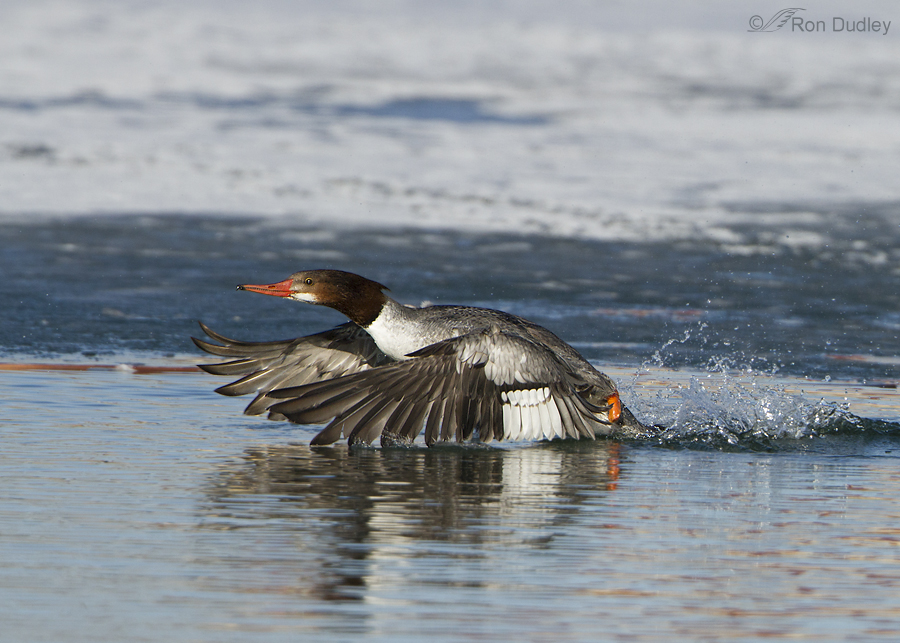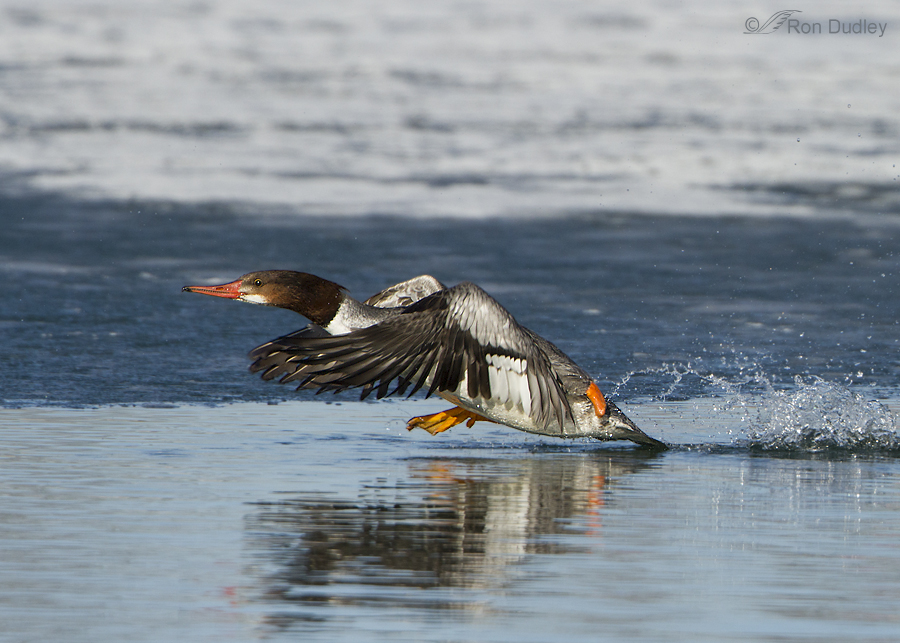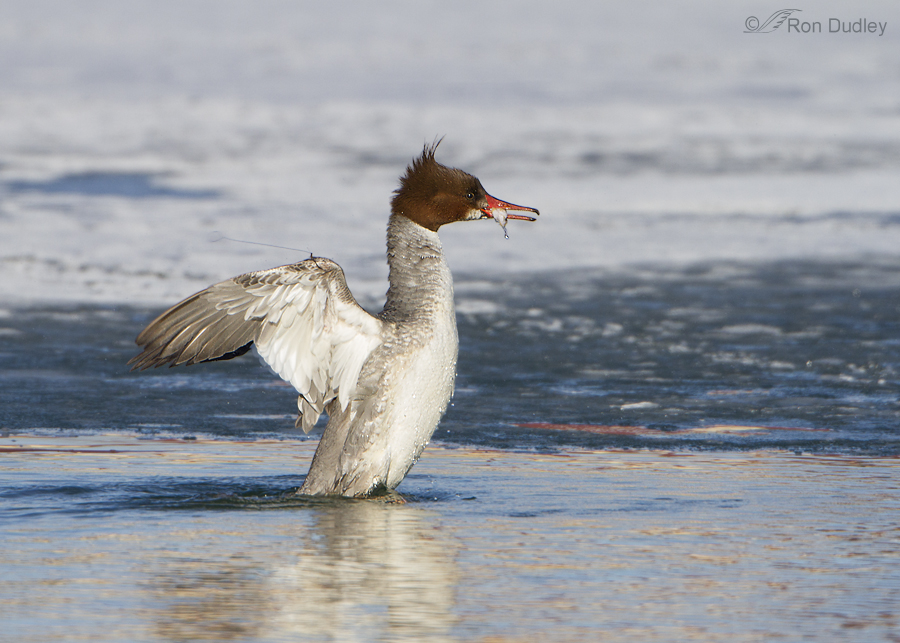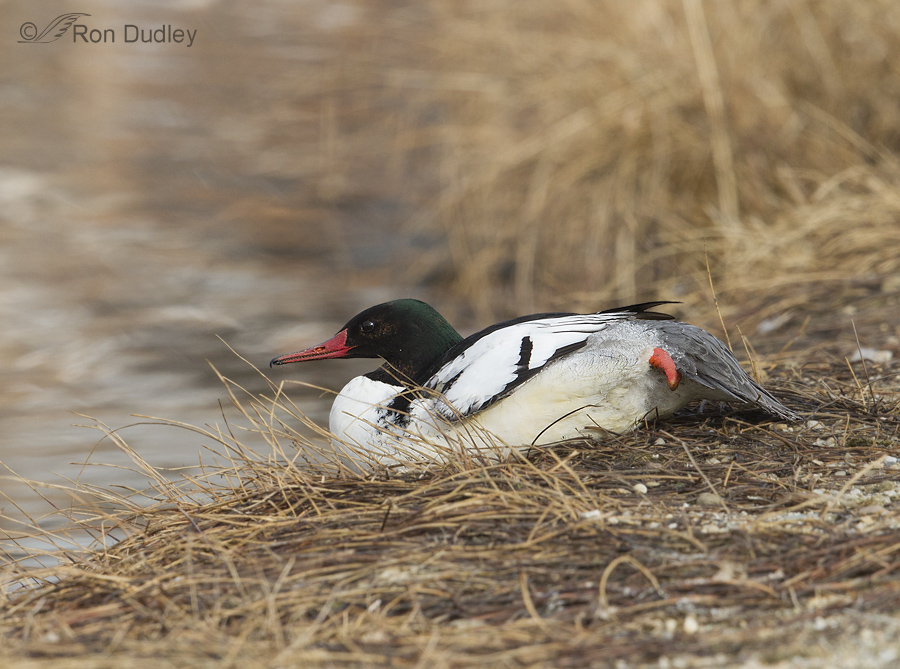With all the recent bad news about critters suffering and dying at the hand of man it’s so refreshing to come across one who has defied the odds and not only survived, but thrived!
But I should start at the beginning…
1/2500, f/7.1, ISO 500, Canon 7D, 500 f/4, 1.4 tc, not baited, set up or called in
Almost exactly a year ago (2/16/13) I photographed this one-footed juvenile male Common Merganser at Willow Pond, an urban fishing pond near my home. Here it’s rushing across the water to investigate a fish that another bird had captured and the “running” pose revealed that the left foot was missing.
1/2500, f/7.1, ISO 500, Canon 7D, 500 f/4, 1.4 tc, not baited, set up or called in
This shot shows the leg stump even more clearly.
The pond was severely littered with discarded and lost fishing line along the shoreline (I can only imagine how much of it was below the surface) and I strongly suspect that this bird’s leg had become entangled in some of the line and circulation was lost, as was the foot. That tentative conclusion on my part is only speculation of course but that speculation was fueled by the two small strands of line coming off this birds other foot (look carefully for them) and by…
1/2000, f/7.1, ISO 500, Canon 7D, 500 f/4, 1.4 tc, not baited, set up or called in
the merganser’s companion – another juvenile with a lure/hook/bait stuck in its bill (this is not simply a small fish ready to be swallowed, that was obvious to me as I watched the bird through my lens). Look closely and you can see more fishing line (looks like a fishing leader) coming off the top of the wing. We also photographed a duck on that morning entangled in fishing line – it’s an insidious and pervasive problem.
I haven’t seen any mergansers on the mostly frozen pond all winter. A few Common Mergansers winter in my area but most seem to go south and I always look forward to their return. I strongly suspected that neither of these birds would survive the winter and to be perfectly honest had mostly forgotten about them until three days ago when I saw an adult merganser basking and preening on the far shore of the pond (very far away) and thought I noticed that it was favoring one of its legs. That sight brought a momentary flashback of the one-footed bird but I just didn’t give it much thought and never even considered the possibility that it could be the same merganser as the year before. I think part of the reason for that is the difference in plumage colors of juveniles and adults (particularly the color of the head).
1/2000, f/6.3, ISO 500, Canon 7D, 500 f/4, not baited, set up or called in
Yesterday morning I was able to get close to the merganser as it basked on the shore in the first warm sunlight we’ve had for a good long while – it was in the same area where I had seen it from across the pond two days before. I took many photos as it rested and preened and in two of those shots it lifted its leg enough to reveal – voila, a missing left foot! Almost certainly this is the same merganser as the year before.
I’m truly impressed. I can’t imagine the severe disadvantage this merganser has in capturing fish underwater (they primarily eat small fish) with only one foot for propulsion. The bird not only survives but it thrives and appears to be healthy as it’s behavior seems to be the same as that of several other mergansers on the pond.
Seeing this bird again made my day.
Ron
For those interested in more background: Last year I contacted Tom Wharton a highly respected columnist for the Salt Lake Tribune who often covers outdoor recreational topics to see if he was interested in doing a story on these birds and the issue of discarded fishing line. He was and he did. For those who haven’t seen it before, here’s the link.






I am so happy to know that this Merganser is thriving. Unfortunately that can’t make up for all the birds and other animals lost to human thoughtlessness. I have been amazed on a number of occasions at how well some of these animals do, despite the misfortune and injuries they encounter. It is always good news when one makes it.
Heartbreaking to see what our carelessness can cause. Glad he’s able to overcome his disability. Great documentation and fantastic images
Sensational shots and an amazing story of survival! Thanks So much for sharing Ron!
charlotte
This post buoyed my spirits Ron! It doesn’t make all that insidious stuff disappear, but maybe it encourages someone, maybe one of us (your followers), to bend down and pick up a handfull of the junk. The power of photography.
It is amazing how Natures Children adapt. I have photographed a one legged Bald Eagle for a number of years along the Mississippi River here in La Crosse, WI. When I first saw her, I figured her for being gone shortly, but to my surprise and delight she has not only survived but has mated with another adult and they have successfully fledged two year groups of young ones. She eats while airborne with the good leg, and her mate brings her food and fights off other Eagles when they see she is with a nice fish, and trying to eat it. I have some photos but only poor quality flying away shots. Hoping to capture some better pics this Spring if she shows again. It saddens me to see these magnificent animals in distress because of us. Great story and series of shots.
That’s truly wonderful!!
Amazing! Happy to see a survivor . As for the fishing lines, it just ticks me off to see the results of the idiocy of some human beings.
Great pictures Ron, and a great article in the local paper, but unfortunately I am not very optimistic about lazy fisherman picking up after themselves. We have a very similar problem in the lake we lived on before moving to where we are now. In one particular area there were 7 plugs with monofilament line hanging from a phone line crossing a portion of the lake. One can just imagine how many lures and line is lost underwater when the lure snags on an underwater branch or log. It is a real shame.
I’m not optimistic either Dick. But then I try to fight my own natural pessimism and at least hope that getting the word out makes things slightly better than they would be otherwise.
Thank you Ron. You have made my morning. If this gutsy little survivor can do it, then I have an obligation to try too. And hiss and spit to those who discard their toys without thought for who or what could be injured. Lines, hooks, nets… too many deaths.
You’ve had a tough row to hoe, Elephant’s Child. I have confidence you “can do it”, just like this gutsy merganser has!!!
Elephant’s Child will definitely “MAKE IT” ….because she’s an Aussie, is an Ellie Baby, and because we are ALL 100% behind her!!! There’s no other outcome!!!
A tearful thank you to you both.
No tears! SMILES!!! :-). ;). (-: (-; :-D. C-: etc., etc., etc…….
The evil iPod changed CANOE into CAPES…nuts!!!
When I used to do a lot of school programs with our injured birds, I would often ask how the kids thought some birds might got hurt. They would sometimes bring up gunshot. For some reason, I started asking them if any of them had ever been shot (and was astounded by the number of hands, including some teachers’, that would go up). When I asked what they thought it would feel like to a bird like a robin to be shot even with something like a beebee gun, one kid said it would feel like a ‘sledgehammer to the chest.’ I should have done that with fish hooks, as I”m sure a lot of them have hurt themselves that way! But relating it to a personal experience was my way of creating empathy and then compassion, letting them know that animals are not animated tin cans for target practice, but feel pain, leave orphans, etc. I got good feedback from parents/teachers on that – and can only hope it left a lasting impression on the kids. I do know that fishing line breaks, sometimes high in bushes – but people should make an effort to clean it up as it’s just a death trap. I have a vague recollection that there are some biodegradable kinds of fishing line now, but I think it takes an extended period of direct sunlight? … That might help a line that’s unreachable but it would be a hazard until it disintegrates – clean up is still the best option.
I like your “teaching instincts”, Louise. A lot. Very similar to the thought processes I used to go through when I was teaching high school biology and zoology. Try to think like they do and let the process work for you. And for them.
I used to love fishing, but the idea of snagging somebody in the mouth, or worse, and dragging them out of their element to a place they could no longer breathe, lost its appeal. I’ve also seen too many discarded line tragedies like this one. The one legged merganser reminds me of a magpie we called Lefty.
I used to enjoy fishing too, Patty but then I realized that my primary reason for doing it was to be out there in nature, not catching fish. I spent more time looking for birds out on or above the water than I did paying attention to my fishing. Bird photography fills that nature niche for me now…
I love this perspective, Ron (and Patty). My dad loved to fish, occasionally, recreationally, and I just couldn’t take to it as a kid. The first salmon I caught was my last. But, I loved being out with him in the boat when he wasn’t fishing, seeing the wildlife and experiencing the elements … so I suspect that’s always a common motivation. I haven’t posted my shots yet, but had two experiences with fishing-line-entangled birds in the past month. Between that and the Snow Geese with hunting injuries I see every February after the season, it is, indeed, a tear-jerking sight to know this merganser is surviving despite the odds! Thank you, Ron
I agree that it’s “just being out there” that’s the real attraction….”Fishing” was mainly an acceptable excuse to just hang out in the peace and quiet of a pond, stream, river, or lake. I still like to cast with a spinning reel, just for the challenge of placing a weighted lure (hookless) exactly where I want it to go…but, mostly, it’s drift, look, listen and relax…capes and kayaks are especially good for this…
Sounds like we graduated from the same “fishing school”, Ingrid (and Patty). I look forward (with hesitation of course) to seeing your images. The word simply needs to get out, hard as it is to look at such photos.
Amazing survival story in your photos. So sad that man does this to these beautiful creatures of nature. The birds have a strong advocate in you. Thanks Ron.
Thank you, Ellen.
Ron, this Merganser was lucky but I shudder when I imagine what it has endured. As a young boy, my fishing fanantic son, learned a valuable life lesson about disposing of fishing line. Along a creek bed, we came upon a dangling dead bird, hung hangman style, from fishing line. Thankfully the impression that visual made has lasted a lifetime and we both continue to preach and teach the proper way to dispose of all trash for the sake of wildlife. Thanks for the the link too. I hope the article brought much needed attention to your pond as well as others.
That kind of visual can make a deep impression, Mary – something I know full well. Even something as seemingly innocuous as kite string can have the same effect. See this post if you’re interested but be warned, it’s unpleasant…
https://www.featheredphotography.com/blog/2013/11/10/kite-string-yet-another-death-trap-for-birds/
Thank you so much for this! It really warms my heart. I was deeply saddened when I read your original post about this little guy. When you mentioned the disadvantage propelling itself underwater it made me wonder what kind of adaptation to its swimming technique it has made to keep from going in circles.
I don’t know how it adapted but it certainly has done so, Sharon. The resilience of nature can sometimes be very impressive, can’t it?
Then other times it can be so very fragile…
Ron, this is made my day, too, as I go about my daily tasks of heating the house with wood while nursing a broken wrist. For me, an uncomfortable inconvenience. For the merganser, a major life challenge! It’s will to survive in such odds is heartwarming indeed… Thanks so much for sharing this!
Good point, Alison – puts it in perspective, doesn’t it? Sure sorry about the broken wrist. I wish you speedy healing!
Alison, you make such a beautiful point. I always consider it in the context of human activity, whether it’s kids plinking birds with air guns or people recklessly doing something that can harm wildlife, that they don’t stop to assess how this one single moment of “fun” in their lives will likely amount to a lifetime of disability for the animal. A lifetime. For however long the he or she manages to live. Every time I see an animal with an injury like this, I think about that.